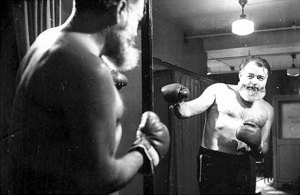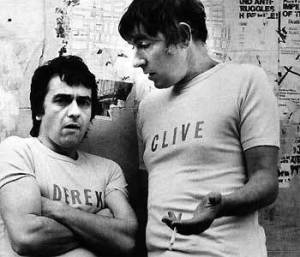Posts Tagged ‘Chris Power’
Update: a reflection on Hemingway
Posted on: July 16, 2011
 If you caught my appraisal of the Ernest Hemingway story, A Clean Well-Lighted Place in the Cafe Shorts series last month, you may be interested to know that the story is mentioned in the the latest instalment of Chris Power’s Guardian Books column, A brief survey of the short story.
If you caught my appraisal of the Ernest Hemingway story, A Clean Well-Lighted Place in the Cafe Shorts series last month, you may be interested to know that the story is mentioned in the the latest instalment of Chris Power’s Guardian Books column, A brief survey of the short story.
Power’s piece describes Ernest Hemingway’s blend of James Joyce’s “form as content” approach, “Hemingway’s [own] journalism training and the tenets of Pound’s Imagism, [resulting in] short, simple sentences mostly comprised of nouns and verbs. Adjectives and adverbs are used sparingly…” This is extremely useful in helping us to understand the evolution of the short story within modernism. What Hemingway did with his prose had, in Power’s words, “a measurable and profound” impact on short fiction (most tellingly, on Raymond Carver) that has followed ever since. The “cup of tea exercise” I brought you recently and my earlier strictures against writing “rowlingly” stem from attitudes entwined with Hemingway’s approach.

CLIVE: I'll tell you another thing gives me the horn. DEREK: What's that? CLIVE: The word "and". DEREK: Oh, "and". CLIVE: Whenever I see the word "and" in a book ..... DEREK: You-, you've picked a favourite of mine there. CLIVE: ..... I get so fucking horny, I- DEREK: Oh, fucking "and", mate. Ohh, Jesus, .....
The Single Moment
Posted on: March 29, 2011
And this is what happens next. The first idea comes in a snowdrift of plans and poetry and urges and explanations, and it’s helped inside and warmed by the fire and sat with a large drink, ready to while the night away with stories. Then it goes to sleep, and in the morning there’s just a puddle on the hearth rug. People who wish to be writers – who don’t believe they are writers, even though they write, because no-one has read them yet – might think that the people who get to call themselves writers no longer experience the atrophy that follows the creation of the earliest passages in a first draft. They – because “they” are other people, who are not me, and the success of this enterprise relies on my insistence on the primacy of my individuality – might imagine that at some point it becomes a job, that at all times each professional writer has something to say about everything so the struggle, to convince yourself that anyone should be bothered to read what you have to say, has somehow been bypassed. Well, if there’s another gap of over a fortnight between posts on this blog, you’ll know that definitely isn’t the case.
One of the reasons I’m starting this blog is because I saw a writing exercise of mine reproduced on the blog of one of my 2nd year university students. He’s sharing his processes for the sake of his own development and I’m all for that, but seeing it made me think that if my techniques are floating about the cyber-wilderness, I ought to make an appearance as well.
This isn’t a course in how to write short stories but a personal (and eventually, I hope, collective) exploration of the mechanisms of the form. Some of this might not seem to have anything to do with writing short stories. But that’s the stuff whose trace elements will be found in what I go on to write, so the tangents are the ones to watch.
Writing on the Guardian books blog last week, Chris Power discussed the way short story writers seek to compress the world into a single moment. Today, I was asked to consider similar ideas when this question was put to me: “If you had to pin it down, what is it about a single moment that makes you shape it into a narrative?”
This is what I had to say:
Resonance. It’s the same way you know a single note of music is music. Because it reminds you of where you’ve heard that note before so you know it to be music – but also because it feels like music with reference to nothing else but itself; hearing it now means you’ll recognise it as music in future. This is the resonance that can be found in a single moment: it resonates with your life because it colours in a thought you may have had, or stimulates a memory, or heightens an emotion; and it resonates across time because these are the moments that stay with you, that seek out other moments with which to connect. But of course, there’s a narrative in every moment so it’s the narratives of your own every day that lead you to the single moments.
And this is how we will continue.